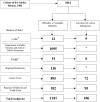Violent delinquency in a Brazilian birth cohort: the roles of breast feeding, early poverty and demographic factors
- PMID: 20078825
- PMCID: PMC2810438
- DOI: 10.1111/j.1365-3016.2009.01091.x
Violent delinquency in a Brazilian birth cohort: the roles of breast feeding, early poverty and demographic factors
Abstract
We investigated the association between breast feeding, economic factors and conviction for violent delinquency by age 25 years among subjects of the 1982 Birth Cohort from Pelotas, Southern Brazil. Information on breast-feeding pattern and duration was collected in childhood, during the 1983, 1984 and 1986 follow-ups. Information on socio-economic and family characteristics was also obtained between 1982 and 1996. Of the 5914 livebirths enrolled in the cohort, 5228 had obtained an identification document within the state of Rio Grande do Sul, and could thus be identified in judiciary databases. The outcome studied was conviction due to a violent act between ages 12 and 25 years. A total of 106 young people had been convicted at least once (3.0% of men and 1.0% of women). Subjects born to black or mixed mothers and coming from low-income families were at higher risk of having been convicted. Neither crude nor adjusted analyses showed any association between breast feeding and conviction for violent delinquency. Violent delinquency apparently depends more on social factors than on individual factors such as breast feeding.
Figures


Similar articles
-
Early Childhood Predictors of Severe Youth Violence in Low-Income Male Adolescents.Child Dev. 2017 Jan;88(1):27-40. doi: 10.1111/cdev.12680. Child Dev. 2017. PMID: 28042897 Free PMC article.
-
Association of Cumulative Childhood Adversity and Adolescent Violent Offending With Suicide in Early Adulthood.JAMA Psychiatry. 2018 Feb 1;75(2):185-193. doi: 10.1001/jamapsychiatry.2017.3788. JAMA Psychiatry. 2018. PMID: 29238825 Free PMC article.
-
Epidemiology of juvenile violence.Child Adolesc Psychiatr Clin N Am. 2000 Oct;9(4):733-48. Child Adolesc Psychiatr Clin N Am. 2000. PMID: 11005003
-
Child maltreatment associates with violent victimization in young adulthood: a Brazilian birth cohort study.BMC Public Health. 2023 Nov 20;23(1):2287. doi: 10.1186/s12889-023-17245-8. BMC Public Health. 2023. PMID: 37985981 Free PMC article.
-
[Violence prevention in childhood and adolescence--a brief overview].Bundesgesundheitsblatt Gesundheitsforschung Gesundheitsschutz. 2016 Jan;59(1):52-6. doi: 10.1007/s00103-015-2265-8. Bundesgesundheitsblatt Gesundheitsforschung Gesundheitsschutz. 2016. PMID: 26459567 Review. German.
Cited by
-
Risk Factors for Antisocial Behavior in Low- and Middle-Income Countries: A Systematic Review of Longitudinal Studies.Crime Justice. 2018 Mar 26;47(1):255-364. doi: 10.1086/696590. Crime Justice. 2018. PMID: 30310248 Free PMC article.
-
Perinatal and sociodemographic factors at birth predicting conduct problems and violence to age 18 years: comparison of Brazilian and British birth cohorts.J Child Psychol Psychiatry. 2015 Aug;56(8):914-22. doi: 10.1111/jcpp.12369. Epub 2014 Dec 4. J Child Psychol Psychiatry. 2015. PMID: 25471542 Free PMC article.
-
Breastfeeding and behavior disorders among children and adolescents: a systematic review.Rev Saude Publica. 2018 Feb 5;52:9. doi: 10.11606/S1518-8787.2018052000439. Rev Saude Publica. 2018. PMID: 29412376 Free PMC article.
-
Childhood individual and family modifiable risk factors for criminal conviction: a 7-year cohort study from Brazil.Sci Rep. 2022 Aug 4;12(1):13381. doi: 10.1038/s41598-022-13975-8. Sci Rep. 2022. PMID: 35927553 Free PMC article.
-
Crime and violence in Brazil: Systematic review of time trends, prevalence rates and risk factors.Aggress Violent Behav. 2013 Sep;18(5):471-483. doi: 10.1016/j.avb.2013.07.003. Aggress Violent Behav. 2013. PMID: 24027422 Free PMC article. Review.
References
-
- Buvinic M, Morrison A, Orlando MB. Violencia, crimen y desarrollo social en América Latina y el Caribe. In: Sojo C, Pérez JP, Franco R, Gutiérrez E, Gordon S, Rodríguez E, et al., editors. Desarrollo Social En América Latina: Temas y Desafíos Para las Políticas Públicas. San José, Costa Rica: FLACSO; 2002. pp. 316–382.
-
- Assis SG, Souza ER. Criando Caim e Abel: pensando a prevenção da infração juvenil. Ciência & Saúde Coletiva. 1999;4:131–144.
-
- Oliván Gonzalvo G. Adolescentes delincuentes: problemas de salud y recomendaciones sanitarias para centros de reforma juvenil. Anales Español de Pediatria. 2002;57:345–353. - PubMed
-
- Loeber R. The stability of antisocial and delinquent child behavior: a review. Child Development. 1982;53:1431–1446. - PubMed
-
- Nagin D, Tremblay RE. Trajectories of boys' physical aggression, opposition, and hyperactivity on the path to physically violent and nonviolent juvenile delinquency. Child Development. 1999;70:1181–1196. - PubMed

